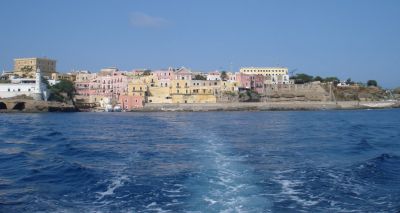La meravigliosa isola di Ventotene, situata al largo della costa tra Lazio e Campania, è una lingua allungata di soli due chilometri di terra vulcanica, attraversata da una storia di 2.000 anni. Con le sue acque cristalline ed i ricchi fondali rappresenta un vero tesoro tra Roma e Napoli e fa parte integrante della riserva marina protetta insieme alla vicina isola di Santo Stefano. Può essere raggiunta in traghetto da Terracina, Formia o Ponza. Già nota dai greci con il nome di Pandaria, Ventotene fu probabilmente usata come punto d’appoggio per le prime colonizzazioni greche. Successivamente divenne una colonia romana ed utilizzata dall’imperatore Augusto come luogo d’esilio per membri dell’impero. Dopo un periodo di declino durante il Medioevo, tornò ad essere urbanizzata grazie ai Borboni ed è in questa epoca che vennero costruiti il borgo attorno al Porto Romano, la chiesa di Santa Candida - centro spirituale dell’isola - ed il maestoso carcere di Santo Stefano ormai in disuso dal 1965. Molto interessanti da visitare, oltre al borgo, al castello ed al Mueso Archeologico, sono anche cisterne costruite in epoca romana, adibite all’approvvigionamento di acqua potabile dell’isola. Sulle sue pareti sono visibili ancora oggi alcuni dipinti e graffiti.
Before you leave for a few days on paradiso to the island of Ventotene, you’ll probably want to jot down a list of what to bring with you: sunscreen, a mask and snorkel, swimsuit, towel, good walking shoes, books, books, and more books - this is a “literary island,” after all. It is thought that Homer intended the small island off the western coast of Italy between Rome and Naples to be the spot where Ulysses confronted the sirens during his long journey home. While visiting Ventotene, here are some not-to-miss experiences:
- Antico Forno Aiello - drop in to taste all the delicious goodness the pastry shop has to offer: tiella alla scarola (escarole focaccia, the bakery’s specialty), all the varieties of ricotta-filled pastries, the eggplant polpette, the filled pizzas, the arancine (rice balls), and more.
- Take a stroll along the ramparts flanked with stucco pastel-tinted houses.
- Enjoy long daily swims in the turquoise waters off the jutting, lavic rocks below the lighthouse and, in the evening, join sea-saturated vacationers browsing in Fabio’s bookstore just opposite the 18th-century municipio (city hall) on Piazza Castello. It’s the island’s cultural heart.
- Take a boat over to the small island of Santo Stefano for Salvatore’s intriguing guided tour of the former prison there, unique in its structure and implementation of innovative prison reforms (ask Fabio for books on the subject.
- Take an evening walk with local guide Silvana through the labyrinthine Roman cisterns which were turned into a prison in the 18th-century.
- Join Elena’s fascinating sunset guided tour of the ruins of the Villa Giulia where Augustus exiled his daughter in the 1st century A.D.
- Sip your morning espresso at the outdoor tables of Bar/Ristorante Da Verde under a canopy of vines.
- Savor all the tasty seafood Ventotene has to offer at its various dockside cafes.
- Don’t miss the 3-hour giro dell’isola (“trip around the island”) on a small boat with stops to swim in the translucent water of hidden coves (reachable only by boat). If you can, book Gianmarco as his passione for his island’s Roman history is contagious.
Now you know what keeps us coming back to this magical island.
https://www.lagazzettaitaliana.com/travel/8853-the-island-of-ventotene-an-essential-checklist#sigProId31415b06ee




